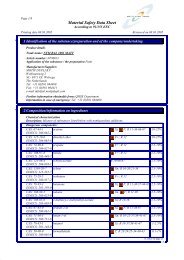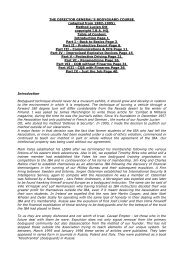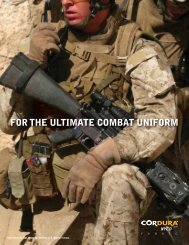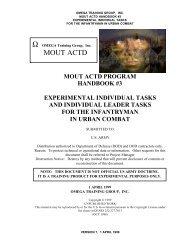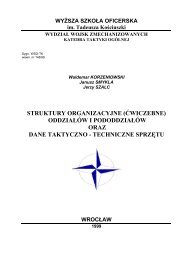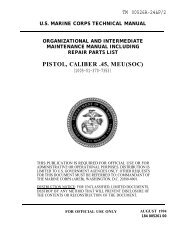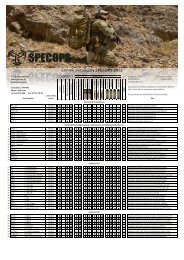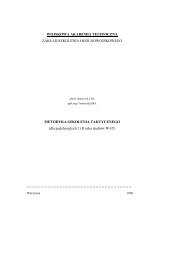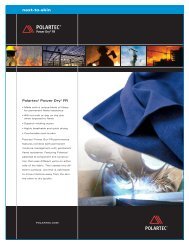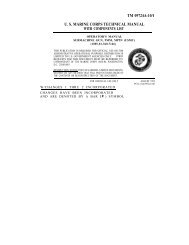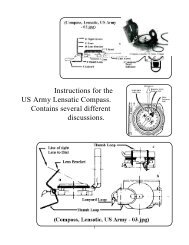mout actd program handbook #1 experimental tactics ... - SpecOps
mout actd program handbook #1 experimental tactics ... - SpecOps
mout actd program handbook #1 experimental tactics ... - SpecOps
Create successful ePaper yourself
Turn your PDF publications into a flip-book with our unique Google optimized e-Paper software.
OMEGA TRAINING GROUP, INC.<br />
MOUT ACTD HANDBOOK <strong>#1</strong><br />
EXPERIMENTAL TACTICS, TECHNIQUES, AND PROCEDURES<br />
FOR THE INFANTRY RIFLE PLATOON AND SQUAD IN URBAN COMBAT<br />
_____________________________________________________________________________<br />
conditions of combat. Due to political change, advances in technology, and the Army's<br />
role in maintaining world order, urban combat now takes on greater dimensions than<br />
before. Infantrymen conduct urban combat operations under many varying conditions<br />
across the spectrum of conflict. These conditions range from large-scale, high-intensity<br />
combat through isolated actions against armed belligerents mixed with noncombatants to<br />
peace operations that may resemble dangerous police work more than traditional combat<br />
in built-up areas. The terms below are expressions used to describe the US force’s<br />
degree of sensitivity to political considerations during the operation being conducted.<br />
The definitions below provide clarity and focus for leaders conducting tactical planning<br />
for combat in an urban environment. However, at the platoon and squad level, the ROE<br />
contain the information that drives the planning and limits the options available to the<br />
leader.<br />
a. High-Intensity Conditions of Urban Combat. Infantry units must be<br />
prepared at all times to conduct violent combat under high-intensity conditions of urban<br />
combat. These conditions are combat actions against a determined enemy occupying<br />
prepared positions or conducting planned attacks. High-intensity conditions of urban<br />
combat require the coordinated application of the full combat power of the joint<br />
combined arms team. An Infantry unit’s mission is normally to seize, to secure, to<br />
clear, or to defend urban terrain, engaging and defeating the enemy by the use of<br />
whatever force is necessary. Although the changing world situation may have made<br />
urban combat under high-intensity conditions less likely for US forces, it represents the<br />
high end of the combat spectrum, and units must be trained for it. High-intensity<br />
conditions of urban combat can be casualty-intensive for both sides. Even though the<br />
full, integrated firepower of the joint combined arms team is brought to bear on the<br />
enemy, leaders must still make attempts to limit unnecessary destruction and casualties<br />
among noncombatants. Historical examples of urban combat under high intensity<br />
conditions include Stalingrad and Arnhem. A recent example of high-intensity urban<br />
combat conditions is the Russian experience in Grozny where the Russians ended up<br />
fighting block by block and creating tremendous collateral damage even though that was<br />
not their intention at the onset of the operation.<br />
b. Precision Conditions of Urban Combat. Conventional forces conduct<br />
combat operations under these conditions to defeat an enemy that is mixed with<br />
noncombatants. Infantry units of all types must routinely expect to operate under<br />
precision conditions of urban combat. They conduct combat operations carefully under<br />
these conditions to limit noncombatant casualties and collateral damage. Under<br />
precision conditions, either the enemy is thoroughly mixed with the noncombatants or<br />
political considerations require that the ROE be significantly more restrictive than under<br />
high-intensity conditions. It may also require specific <strong>tactics</strong>, techniques, and<br />
procedures (TTP) for precise use of combat power. Some of this combat can be quite<br />
violent for short periods. It is marked, however, by conscious acceptance by US forces<br />
of the need to focus and restrain the combat power used. The platoon or squad leader<br />
may bring overwhelming force to bear, but only on specific portions of the urban area<br />
_____________________________________________________________________________<br />
1-2<br />
VERSION 7, 1 APRIL 1999



